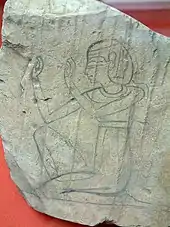Man-seated: arms in adoration (hieroglyph)
The ancient Egyptian Man-seated: arms in adoration hieroglyph is one of a series of language and visual hieroglyphs used from the earliest dynasties of Ancient Egypt, and that portrays men, women, ideology, and some occupations.
| Seated Man Arms Raised in Adoration in hieroglyphs |
|---|
| Standing person Arms raised in Adoration in hieroglyphs |
|---|
Used versions of the adoration hieroglyph are with men, women, and groups of individuals; also the adoration-type hieroglyph is shown in a standing pose, with upraised arms. The men and women hieroglyphs of both the men and women series, encompass a majority of the human traits, forms, emotions, etc.
Use in priest-libationer hieroglyph
| Plural 3 (Libationer), Priests in hieroglyphs |
|---|
A major use of the seated-adoration hieroglyph would be as part of the Libationer-Priest (hieroglyph). Although the main man-seated, adoration hieroglyph is not used in the Rosetta Stone, the Libation-priest is used throughout (beginning at the early lines of the first half of the Decree of Memphis (Ptolemy V), the named Nubayrah Stele). One use on the Rosetta Stone 2nd half of the Libationer-priest is the plural of the priests. The last part of the Decree of Memphis, Ptolemy V-(Rosetta Stone), is to honor Pharaoh Ptolemy by enacting ten items. In the next-to-last line, line R-13, one enactment is:
- "The priests (Libationer hieroglyphs), of the temples in temple every by its name, shall be called "priest of the god appearing (epiphanous), lord of benefits," (Greek: eucharistos), in addition to the ranks of priests of them (in addition to their other priestly titles). Let write them it upon documents theirs, ...."
Example usage: an ostracon
An example of a single scene is shown on the pictured ostracon.
See also
| Wikimedia Commons has media related to Squatting man, worshiping (hieroglyph). |
| Wikimedia Commons has media related to Hieroglyphs of Egypt. |
References
- Budge. An Egyptian Hieroglyphic Dictionary, E.A.Wallace Budge, (Dover Publications), c 1978, (c 1920), Dover edition, 1978. (In two volumes) (softcover, ISBN 0-486-23615-3)
